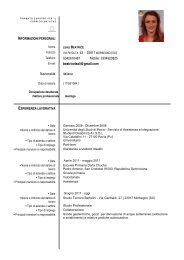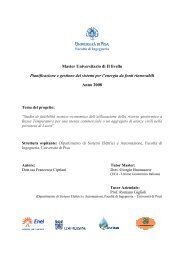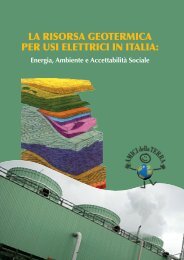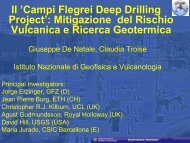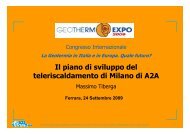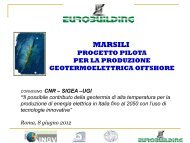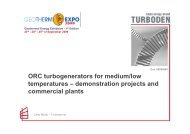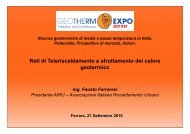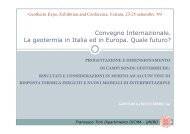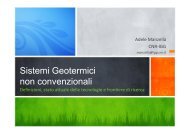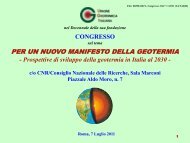Scarica la pubblicazione in formato PDF - Unione Geotermica Italiana
Scarica la pubblicazione in formato PDF - Unione Geotermica Italiana
Scarica la pubblicazione in formato PDF - Unione Geotermica Italiana
You also want an ePaper? Increase the reach of your titles
YUMPU automatically turns print PDFs into web optimized ePapers that Google loves.
III<br />
L’aumento è dovuto soprattutto al maggior apporto<br />
degli usi diretti del calore, che sono passati<br />
da 0,2 MTEP del 2005 a 0,3 MTEP del 2010, con<br />
un <strong>in</strong>cremento medio annuo dell’8,5%. La produzione<br />
di energia geotermoelettrica, <strong>in</strong>vece, pur essendo<br />
stata prevalente rispetto agli usi diretti, è<br />
aumentata nello stesso periodo da 0,99 ad 1,02<br />
MTEP, con un tasso di <strong>in</strong>cremento medio di appena<br />
lo 0,6% all’anno.<br />
Si è verificata qu<strong>in</strong>di dal 2005 al 2010 una crescita<br />
complessiva del<strong>la</strong> geotermia molto modesta rispetto<br />
al grande potenziale di cui l’Italia dispone,<br />
soprattutto per usi diretti.<br />
3. Sviluppo del<strong>la</strong> geotermia f<strong>in</strong>o al 2030<br />
Premesso quanto sopra, per vedere quale ragionevole<br />
contributo il calore del<strong>la</strong> Terra può dare<br />
al<strong>la</strong> futura copertura dei fabbisogni nazionali di<br />
energia, e per <strong>la</strong>nciare qu<strong>in</strong>di un Nuovo Manifesto<br />
del<strong>la</strong> Geotermia <strong>Italiana</strong> con visione più ampia<br />
dell’altro simile “Manifesto” pubblicato dall’UGI<br />
quasi 5 anni fa, è stato impostato agli <strong>in</strong>izi del<br />
2011 e recentemente concluso lo studio <strong>in</strong> oggetto,<br />
con tappe temporizzate al 2012, 2015,<br />
2020, 2025 e 2030, <strong>in</strong> modo da poter fare periodici<br />
aggiornamenti.<br />
In base allora alle caratteristiche geologiche del territorio<br />
italiano ed al tipo di risorse geotermiche esistenti<br />
f<strong>in</strong>o a 5 km di profondità, considerando il<br />
probabile forte aumento dei prezzi dei combustibili<br />
fossili nei prossimi anni, e tenendo presenti i<br />
miglioramenti attesi dal<strong>la</strong> tecnologia di utilizzazione<br />
del calore terrestre, le stime di sviluppo sono<br />
state fatte, separatamente per <strong>la</strong> produzione di<br />
energia elettrica e per gli usi diretti, secondo i due<br />
seguenti diversi scenari di crescita:<br />
Scenario I: trend di sviluppo economico-sociale<br />
corrente, uso di tecnologie di produzione quasi soltanto<br />
mature, e prezzi al<strong>la</strong> fonte del greggio al 2030<br />
di 250 US $/barile (circa tre volte più alti, cioè, di<br />
quelli medi del 2010, che sono stati 80 US $/barile<br />
≈ 400-420 €/tonn);<br />
Scenario II: trend di sviluppo economico-sociale<br />
tra<strong>in</strong>ato da scelte politiche forti <strong>in</strong> senso ecologico,<br />
uso di tecnologie di produzione non solo mature<br />
ma anche avanzate, e prezzi al<strong>la</strong> fonte del greggio<br />
al 2030 di 300 US$/barile (circa quattro volte più<br />
alti, cioè, di quelli del 2010).<br />
The <strong>in</strong>crease is mostly owed to direct uses of natural<br />
heat, which passed from 0.2 MTOE <strong>in</strong> 2005 to 0.3<br />
MTOE <strong>in</strong> 2010: an average growth rate of 8.5%<br />
per year. In contrast, even though geothermal po -<br />
wer generation was dom<strong>in</strong>ant over direct uses, it<br />
ro se <strong>in</strong> the same period from 0.99 to 1.02 MTOE,<br />
i.e. at an average growth rate of as little as 0.6%<br />
per year.<br />
Consequently, from 2005 to 2010, geothermal deployment<br />
was rather poor as compared to Italy’s<br />
<strong>la</strong>rge geothermal potential, especially for direct<br />
uses.<br />
3. Italian geothermal development by 2030<br />
In early 2011, a study was <strong>in</strong>itiated to estimate the<br />
possible contribution of the Earth’s heat to the cove -<br />
ra ge of national energy requirements by 2030, with<br />
steps by 2012, 2015, 2020, 2025 to be periodically<br />
updated. The end goal of the study was to provide<br />
the Italian Government with factual elements on the<br />
possible medium-term deployment of this energy<br />
sour ce <strong>in</strong> Italy, as well as to <strong>la</strong>unch a New Ita lian<br />
Geothermal Manifesto with a wider vision than the<br />
one published by UGI almost five years ago.<br />
Growth projections were formu<strong>la</strong>ted by tak<strong>in</strong>g<br />
<strong>in</strong>to account: i) Italy’s geological sett<strong>in</strong>g and geo -<br />
thermal resources known or supposed to exist<br />
down to 5 km depth; ii) likely sharp <strong>in</strong>crease <strong>in</strong><br />
fossil fuel prices <strong>in</strong> the next years; and iii) expected<br />
technological improvements <strong>in</strong> the utilization<br />
of the Earth’s heat. Two different growth<br />
scenarios have thus been developed on the follow<strong>in</strong>g<br />
assumptions:<br />
Scenario I: current economic trend, use of mature<br />
production technologies, and prices of crude oil at<br />
source of 250 US $/bbl <strong>in</strong> 2030 (roughly three ti -<br />
mes higher than the average ones <strong>in</strong> 2010, i.e. 80<br />
US $/bbl, or € 400-420/tonne);<br />
Scenario II: economic trend driven by vigorous<br />
environmental policies, use of both mature and<br />
advanced production technologies, and prices of<br />
crude oil at source of 300 US $/bbl <strong>in</strong> 2030<br />
(roughly four times higher than <strong>in</strong> 2010).




